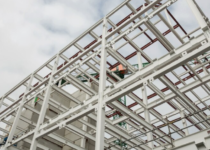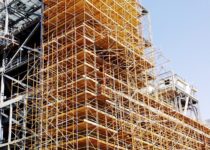Cuplock Scaffolding – Types, Uses, and Benefits
Sparsteel Cuplock Scaffolding is the most widely used scaffolding system in the Middle East. It is galvanized or multipurpose steel scaffolding system suitable for providing general access and supporting vertical loads.
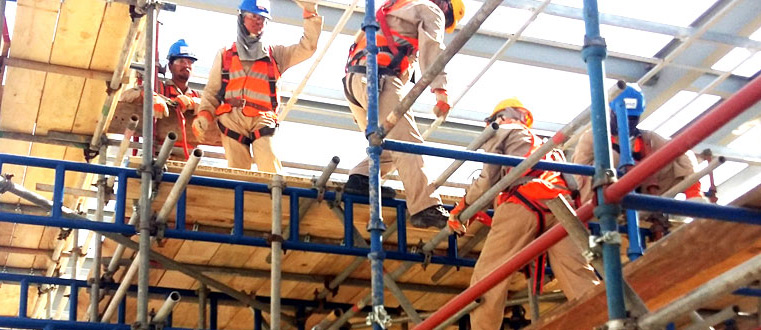
The main feature of a cuplock scaffold is the unique circular cup-node point that allows up to 4 horizontally connected scaffolds in a single installation – possibly making it the fastest and safest system available.
The wide range of cuplock scaffolding components allows it to be used with conventional scaffolding panels or beams. It can be used to construct a wide variety of access and support structures, including stair towers, circular scaffolding, loading towers, and mobile towers.
Hot-dip galvanizing is the best practical coating that can be applied to the scaffolding system, providing a longer working life and better operation. The Sparsteel Cuplock System is manufactured under the most stringent quality standards which are maintained and accredited worldwide by the Sparsteel Quality Control Department.
This guide is designed to enable Cuplock users to plan and build the Best Cuplock scaffolding. Provides comprehensive descriptions of components and guidance on the design and construction of access and support structures.
For more information on safe manufacturing procedures, please refer to the relevant Sparsteel User Manual. If you need more advice regarding designing more complex applications, please contact your local Sparsteel branch:
Scaffolding, cuplocks systems should be erected and dismantled in oil & Gas, petrochemical, refinery by trained & certified Scaffolders, Sparsteel conducts a series of training courses covering all aspects of assembly and inspection of steel Scaffolding towers, scaffolding systems, and electrical access. Sparsteel provide training & certification to its Scaffolder from NASC, TG20-13, SG4-10, SG6, BS EN 12811, Scafftag System, CISRS and C.I.T.B
The Cuplock Locking Procedure
At the heart of the Cuplock system is its unique node point locking device. This allows up to four horizontals to be attached loosely but securely to the standard and then locked into position with a single hammer stroke. The system does not use any loose clips, screws, or wedges.
The locking device consists of a fixed bottom cup, welded as standard at 0.5m intervals, and a sliding top cup that drops horizontally over the blade ends to lock them securely in place while providing positive and solid contact.
This revolutionary node point is what makes installing the SparSteel Cuplock faster and simpler than any other system scaffolder. Once the cuplock structure is “upright” and level, subsequent lifts are automatically created horizontally and squarely.
The absence of loose components makes the system exceptionally easy to use and robust – and its galvanized finish makes it virtually immune to wear and damage.
Cuplock Accessories:
One of the major strengths of the Cuplock scaffolding system is the simplicity of the component range. The horizontal and vertical foundation forms the core of all structures. However, with a small number of specialized components, complex scaffolding can be created that safely address inappropriate access requirements.
Standard Access (Vertical)

Manufactured from high-quality 48.3mm x 3.2mm EN10219 steel tube, all standards include fixed low cups at 0.5m intervals, with a rotatable top cup that secures up to 4 components. The narrowest bottom cup is 80mm from the standard base to give better structural strength to the scaffold and reduce the need for base bracing in supporting structures. Access standards include a 150mm spigot at the top to allow vertical connection to the front end. A lock pin is also provided.
Base and Head Plate

Used in conjunction with Universal Jack. The spigot is drilled to allow a tight bolt to be inserted if necessary.
Horizontals (Ledgers and Transoms)
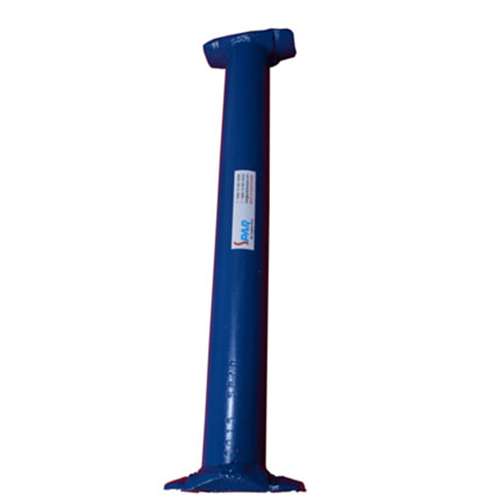
All lasers and jacks include a symmetrical assembly for shaping the blade tip to be quick and simple, allowing for complete component interchangeability. The horizontal scales are located in the bottom cup.
• 2.5 m bay is secured in cuplock access structure. This is a suitable bay size for all common access load conditions.
• 1.8m horizontally provides a make-up shaper for extra flexibility
• 1.3 m transoms have a 5-panel platform. This crossbar can also be used horizontally for added flexibility and to create corner returns without overlapping panels.
• Regular horizontals also serve as handrails
Universal Jack
Universal Jack has an adjustment of approximately 0.5 m and is used for both access and support structures to accommodate differences in-ground and surface levels. It can be attached to the base and headboard, front, or adapter using standard nuts and bolts if required. To support a bearing capacity of 74 kN.
Intermediate Transoms
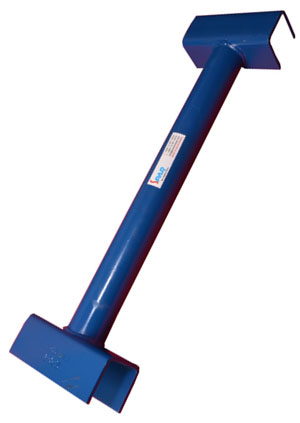
Intermediate Transoms provide mid-bay support for the 38mm scaffolding boards that span between internal and external ledgers. The jaw portion at each end is folded down to prevent dislocation. One end is fitted with an integrated locking device to prevent any movement along with the laser during use. In addition to the standard unit with a width of 1.3 m, smaller intermediate slings are available for use where scaffolding panels require support between Hop-up Brackets. They are spaced between the internal ledger of the main scaffold and the ledger connecting the Hop-up Brackets. For use with 2 boards and 3 board hop-up brackets respectively.
Hop-up Brackets
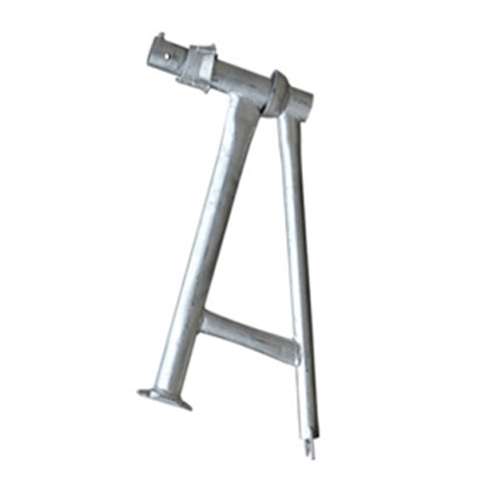
Designed to increase the overall work platform width to seven or eight panels by supporting two or three additional panels outside the interior of the scaffold. It incorporates a cup joint on the outer end to allow for the installation of an internal ledger that connects the two Hop-up brackets and supports the intermediate crossbar. Also included is a feature to support the railing post.
Leading Cuplock Scaffolding Manufacturers and Suppliers in Dubai, UAE
SPAR Steel is a leading manufacturer of cuplock scaffolding in UAE, Saudi Arabia, Bahrain, Oman, Kuwait, Qatar & other Middle East countries. You can get the complete Cuplock accessories here. Include standard cuplock, ledger, bevel and brackets, adjustable leveling jack and U head, cuplock steel plate, base plate, etc.
As an ISO-certified Cuplock Scaffolding manufacturer, we guarantee the quality and safety of your Cuplock accessories:
Cuplock raw materials including cuplock tubes, cuplock cups, and Ledger blades are tested and qualified before production.
Welding lines are tested according to ISO certification.
Additionally, regular system scaffold model checks ensure that your cuplock scaffolding components are well-matched to each other. We also provide you with installation instructions for Cuplock Scaffolding Systems.
With more than 20 years of manufacturing and exporting experience, SparSteel provides any size of Cuplock Scaffolding Accessories all over the UAE (Dubai, Abu Dhabi, Sharjah, Ajman, Ras Al Khaimah, Fujairah & Umm Al Quwain).
Send us your cuplock scaffolding construction requirements now for a favorable price.
Frequently Asked Questions
What is cuplock system?
Cuplock scaffolding is a kind of steel scaffolding system. At Cuplock System Scaffolding you can find a variety of ready-made cuplock scaffolding components including cuplock standards, ledgers, Transom, brackets, adjustable slings, steel plates, and girders.
With components, you can create different types and sizes of scaffolding, and formwork scaffolding for industries, construction, building, and structures.
Sparsteel Cuplock scaffolding materials are used in various construction, industrial scaffolding, commercial and structural construction. Here you can find galvanized, powder-coated, and painted cuplock scaffolding materials. All Cuplock system scaffolding materials are tested and certified to international scaffolding standards.
The Cuplock System is a modular prefabricated scaffolding system used for construction stages and concrete supports. The cuplock system is assembled by cuplock scaffold parts. While cuplock scaffolding parts are made of cuplock accessories for the upper cup, lower cup, flange blades, etc.
Cuplock system parts include standard cuplock, ledger, brackets, adjustable leveling jack base, etc. In accordance with the permissible safety load, there are lightweight and durable Cuplock systems.
Light-duty cuplock system parts are made of OD48x3.2mm scaffolding tubes (Type 3 tubes). While the heavy-duty cuplock system components are manufactured by OD48.3 x 4.0 scaffold tubes (type 4 tube).
How to use Cuplock Scaffolding?
As a scaffolding system, cuplock scaffolding assembly and disassembly are simpler than tubular and clamp scaffolding systems. The following video guide on how to assemble cuplock scaffolding in masonry.
During the construction work of the cuplock system, there must be a unique design when the scaffolding exceeds the following height:
24 m. single (putlog) scaffolding with more than
50 m. double scaffolding
Scaffolding cantilever 20 m. more than
30 m. Full framing for scaffolding
Cuplock Scaffolding System Size?
Standard sizes for SparSteel Cuplock System include 0.5m, 1.0m, 1.5m, 2.0m, 3.0m, etc. While cuplock laser size is customized to 0.6-3.0m.
Cuplock system scaffolding prop sizes depend on the bay shape of the cuplock ledger as well as the cuplock vertical size. While vertical bay sizes can be options of 1.0m, 1.5m, 2.0m, 2.5m, etc.
How to calculate the amount of Cuplock scaffolding?
Cuplock scaffolding can be quantified by a Trained Scaffolding Engineer or scaffolding estimation software. It can also calculate according to the scaffold area to build a cuplock.
Basically, there are two ways to calculate the amount of cuplock.
Calculate the volume of cuplock scaffolding around the building.
Calculation of the volume of cuplock scaffolding supports from concrete slabs and beams.

